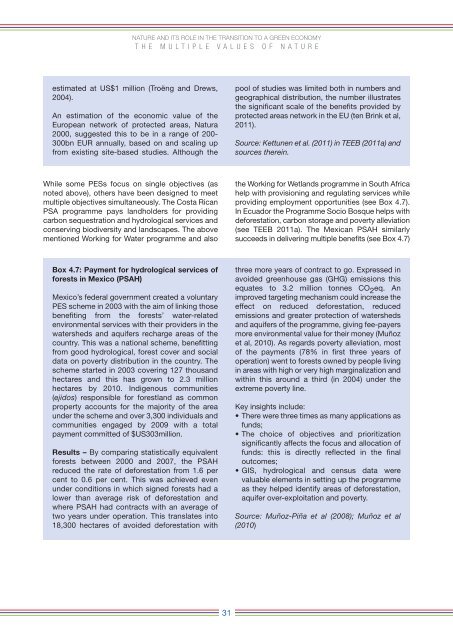Green-Economy-Report
Green-Economy-Report
Green-Economy-Report
Create successful ePaper yourself
Turn your PDF publications into a flip-book with our unique Google optimized e-Paper software.
NATURE AND ITS ROLE IN THE TRANSITION TO A GREEN ECONOMY<br />
T H E M U L T I P L E V A L U E S O F N A T U R E<br />
estimated at US$1 million (Troëng and Drews,<br />
2004).<br />
An estimation of the economic value of the<br />
European network of protected areas, Natura<br />
2000, suggested this to be in a range of 200-<br />
300bn EUR annually, based on and scaling up<br />
from existing site-based studies. Although the<br />
While some PESs focus on single objectives (as<br />
noted above), others have been designed to meet<br />
multiple objectives simultaneously. The Costa Rican<br />
PSA programme pays landholders for providing<br />
carbon sequestration and hydrological services and<br />
conserving biodiversity and landscapes. The above<br />
mentioned Working for Water programme and also<br />
Box 4.7: Payment for hydrological services of<br />
forests in Mexico (PSAH)<br />
Mexico’s federal government created a voluntary<br />
PES scheme in 2003 with the aim of linking those<br />
benefiting from the forests’ water-related<br />
environmental services with their providers in the<br />
watersheds and aquifers recharge areas of the<br />
country. This was a national scheme, benefitting<br />
from good hydrological, forest cover and social<br />
data on poverty distribution in the country. The<br />
scheme started in 2003 covering 127 thousand<br />
hectares and this has grown to 2.3 million<br />
hectares by 2010. Indigenous communities<br />
(ejidos) responsible for forestland as common<br />
property accounts for the majority of the area<br />
under the scheme and over 3,300 individuals and<br />
communities engaged by 2009 with a total<br />
payment committed of $US303million.<br />
Results – By comparing statistically equivalent<br />
forests between 2000 and 2007, the PSAH<br />
reduced the rate of deforestation from 1.6 per<br />
cent to 0.6 per cent. This was achieved even<br />
under conditions in which signed forests had a<br />
lower than average risk of deforestation and<br />
where PSAH had contracts with an average of<br />
two years under operation. This translates into<br />
18,300 hectares of avoided deforestation with<br />
31<br />
pool of studies was limited both in numbers and<br />
geographical distribution, the number illustrates<br />
the significant scale of the benefits provided by<br />
protected areas network in the EU (ten Brink et al,<br />
2011).<br />
Source: Kettunen et al. (2011) in TEEB (2011a) and<br />
sources therein.<br />
the Working for Wetlands programme in South Africa<br />
help with provisioning and regulating services while<br />
providing employment opportunities (see Box 4.7).<br />
In Ecuador the Programme Socio Bosque helps with<br />
deforestation, carbon storage and poverty alleviation<br />
(see TEEB 2011a). The Mexican PSAH similarly<br />
succeeds in delivering multiple benefits (see Box 4.7)<br />
three more years of contract to go. Expressed in<br />
avoided greenhouse gas (GHG) emissions this<br />
equates to 3.2 million tonnes CO 2 eq. An<br />
improved targeting mechanism could increase the<br />
effect on reduced deforestation, reduced<br />
emissions and greater protection of watersheds<br />
and aquifers of the programme, giving fee-payers<br />
more environmental value for their money (Muñoz<br />
et al, 2010). As regards poverty alleviation, most<br />
of the payments (78% in first three years of<br />
operation) went to forests owned by people living<br />
in areas with high or very high marginalization and<br />
within this around a third (in 2004) under the<br />
extreme poverty line.<br />
Key insights include:<br />
• There were three times as many applications as<br />
funds;<br />
• The choice of objectives and prioritization<br />
significantly affects the focus and allocation of<br />
funds: this is directly reflected in the final<br />
outcomes;<br />
• GIS, hydrological and census data were<br />
valuable elements in setting up the programme<br />
as they helped identify areas of deforestation,<br />
aquifer over-exploitation and poverty.<br />
Source: Muñoz-Piña et al (2008); Muñoz et al<br />
(2010)


